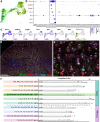A harmonized atlas of mouse spinal cord cell types and their spatial organization
- PMID: 34588430
- PMCID: PMC8481483
- DOI: 10.1038/s41467-021-25125-1
A harmonized atlas of mouse spinal cord cell types and their spatial organization
Erratum in
-
Author Correction: A harmonized atlas of mouse spinal cord cell types and their spatial organization.Nat Commun. 2022 Feb 18;13(1):1033. doi: 10.1038/s41467-022-28698-7. Nat Commun. 2022. PMID: 35181658 Free PMC article. No abstract available.
-
Author Correction: A harmonized atlas of mouse spinal cord cell types and their spatial organization.Nat Commun. 2022 Oct 19;13(1):6184. doi: 10.1038/s41467-022-33998-z. Nat Commun. 2022. PMID: 36261425 Free PMC article. No abstract available.
Abstract
Single-cell RNA sequencing data can unveil the molecular diversity of cell types. Cell type atlases of the mouse spinal cord have been published in recent years but have not been integrated together. Here, we generate an atlas of spinal cell types based on single-cell transcriptomic data, unifying the available datasets into a common reference framework. We report a hierarchical structure of postnatal cell type relationships, with location providing the highest level of organization, then neurotransmitter status, family, and finally, dozens of refined populations. We validate a combinatorial marker code for each neuronal cell type and map their spatial distributions in the adult spinal cord. We also show complex lineage relationships among postnatal cell types. Additionally, we develop an open-source cell type classifier, SeqSeek, to facilitate the standardization of cell type identification. This work provides an integrated view of spinal cell types, their gene expression signatures, and their molecular organization.
© 2021. This is a U.S. Government work and not under copyright protection in the US; foreign copyright protection may apply.
Conflict of interest statement
The authors declare no competing interests.
Figures






References
Publication types
MeSH terms
Grants and funding
LinkOut - more resources
Full Text Sources
Other Literature Sources

